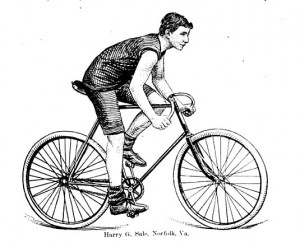 A common message from bicycle organizations and advocates is bicyclists must follow all the rules of the road.
A common message from bicycle organizations and advocates is bicyclists must follow all the rules of the road.
We believe that those who stand firm by that message (a) aren’t doing as they say, or (b) don’t live in urbanized areas with stop signs on every other residential block, which makes cycling impractical. This message is the easy way out since it puts the burden on bicyclists.
Instead, that message needs to be turned around. It should be that we need to change the rules of the road and our road infrastructure to better accommodate bicycling. This message requires more effort and puts the primary burden on bicycle advocates and local governments.
We’ve already highlighted one change to the rules of the road that would be highly beneficial to bicycling: rolling stops. Rolling stops could improve cycling safety according to a recent BBC article, which notes that “an internal report for Transport for London concluded women cyclists are far more likely to be killed by lorries because, unlike men, they tend to obey red lights and wait at junctions in the driver’s blind spot.”
And, you can’t have group bike rides without rolling stops.
Stop signs don’t calm traffic
One beneficial change to the road infrastructure includes removing unnecessary stop signs in residential neighborhoods.
Most of these signs were installed because there was a perception that it would slow speeding motorists. Studies show that that perception is wrong. Motorists actually speed more between stop signs to make up the time lost to stopping — actually only slowing in most cases. These stop signs are not warranted according to state and federal guidelines. They waste fuel, create more pollutants, and help create more noise.
And in most cases, these stop signs are irrelevant for cyclists. We’re not the ones speeding through the residential streets and putting children, pets, and pedestrians at risk. Cyclists, pedestrians, horses, and street cars were doing fine for 36 years without any stop signs. Stop signs were invented in Detroit in 1915 to deal with the mass adoption of motor vehicles.
Removing stop signs
Yesterday’s Free Press has an article on cities removing stop signs in residential areas. Livonia has removed an estimated 1,500 stop signs. Other cities are doing the same, though to a lessor extent.
Grosse Pointe Woods has removed 18 stops signs since November, and Livonia police Sgt. Dave Studt, the person in charge of his city’s traffic bureau, said Farmington Hills and Novi have expressed interest in Livonia’s efforts.
“By removing these stop signs, we’ve just made it safer for a pedestrian to cross the road,” Studt said. He noted that drivers tend to roll through intersections without stopping completely when a street is oversigned or they speed between stop signs in order to make up time.
He said signs are removed only where they are unwarranted because of traffic flow and other factors.
As a member of the Traffic Safety committee in Royal Oak, we see a half dozen requests for new residential stop signs annually. What the residents really want is a means for slowing speeding motor vehicles while reducing cut-through traffic and noise. On some streets, the majority of motorists are speeding. Royal Oak does not have the resources to police this. The residents need real traffic calming solutions, like neckdowns and roundabouts. Those can be implemented in ways that accomodate bicycling.
 There were certainly fewer rules for Detroit cyclists in July 1900. Unlike today, bells and lights were not required on bicycles.
There were certainly fewer rules for Detroit cyclists in July 1900. Unlike today, bells and lights were not required on bicycles. A common message from bicycle organizations and advocates is bicyclists must follow all the rules of the road.
A common message from bicycle organizations and advocates is bicyclists must follow all the rules of the road. Make the Motor City Smaller
Make the Motor City Smaller